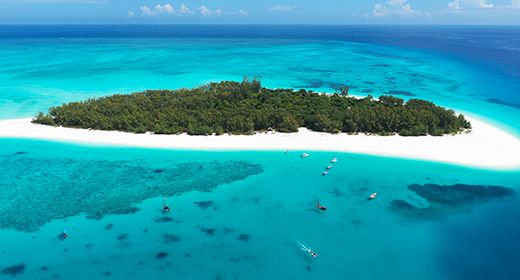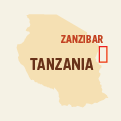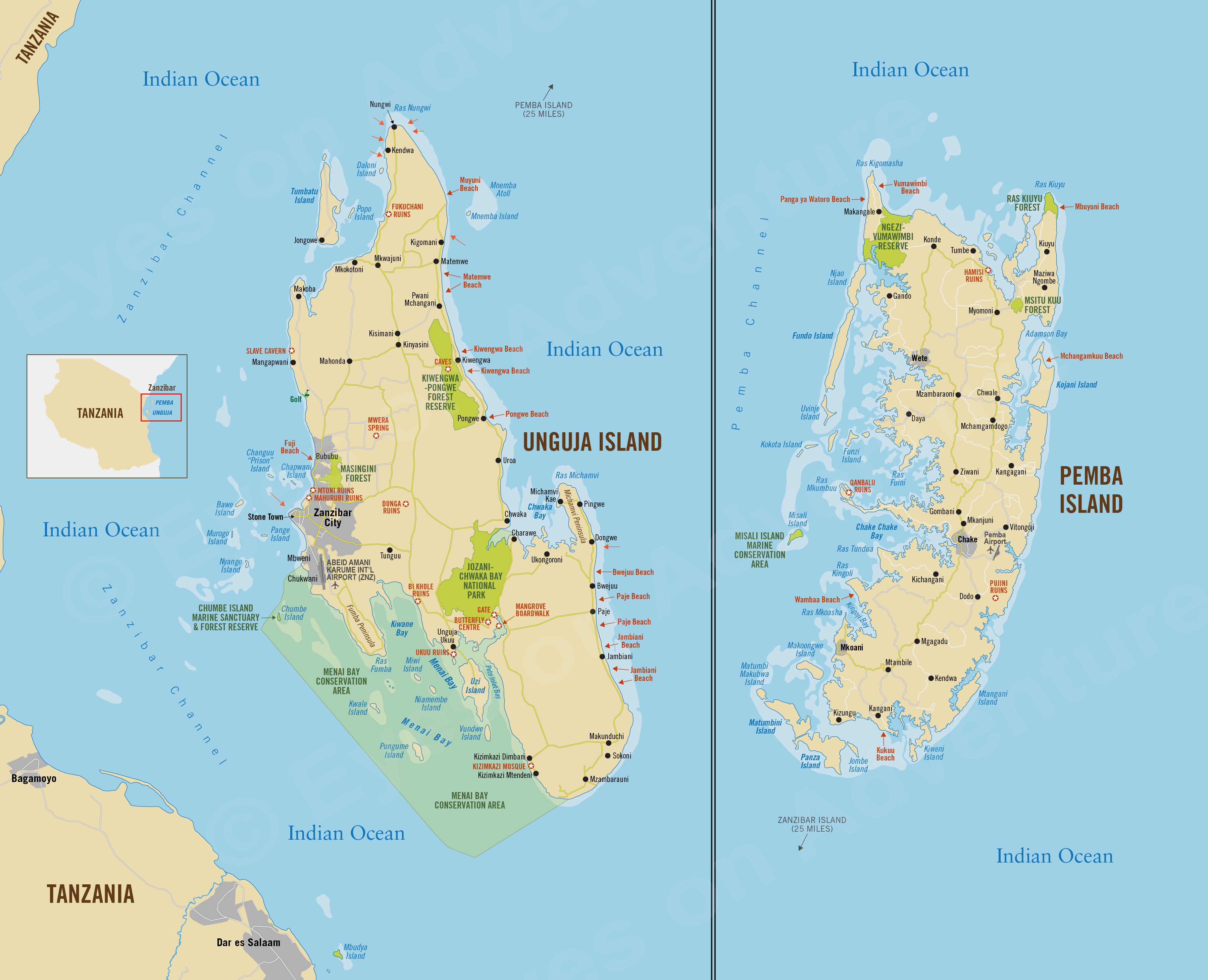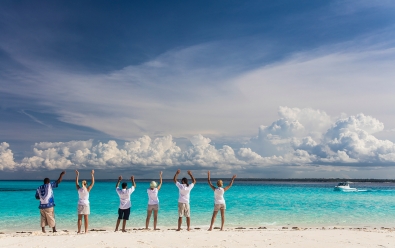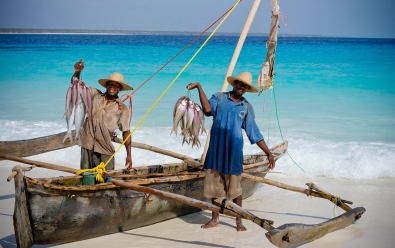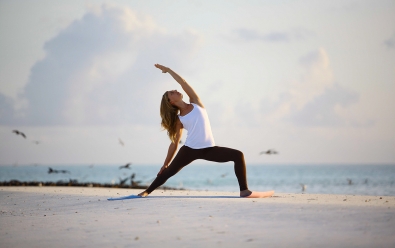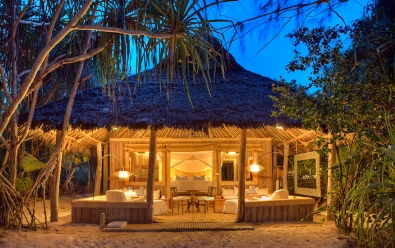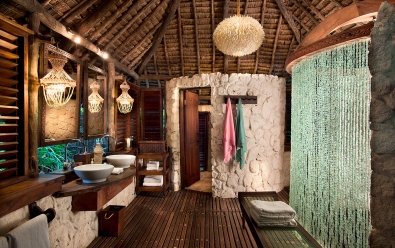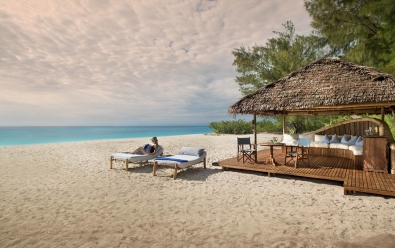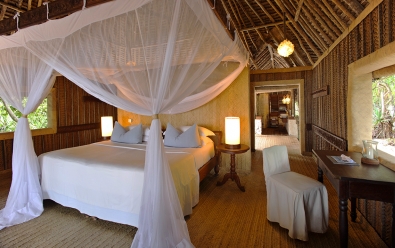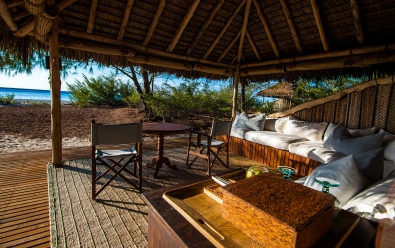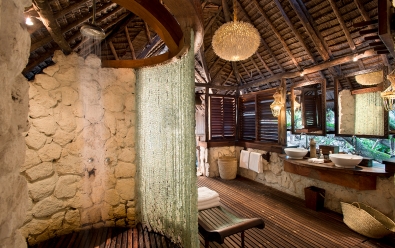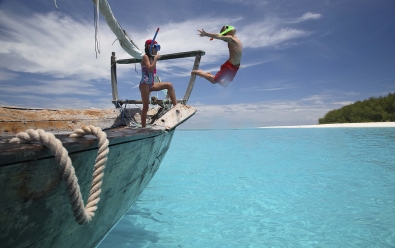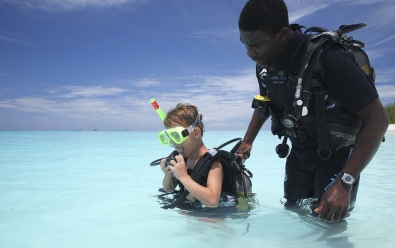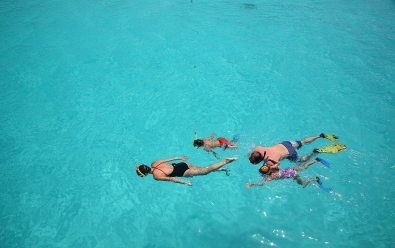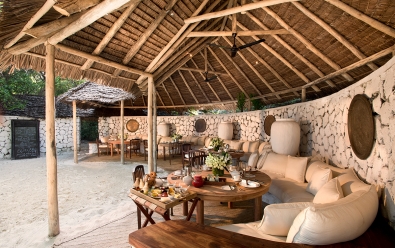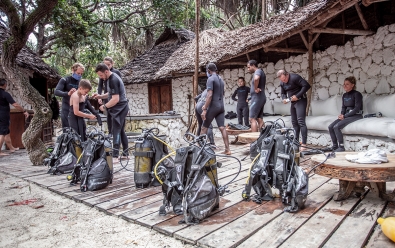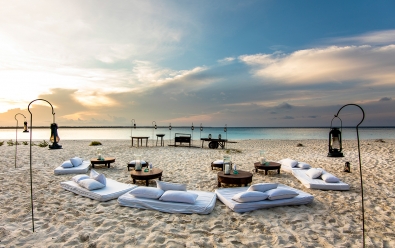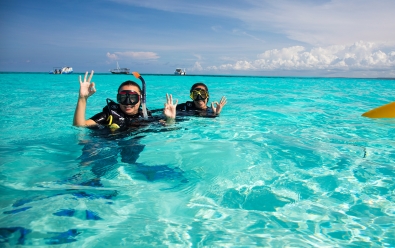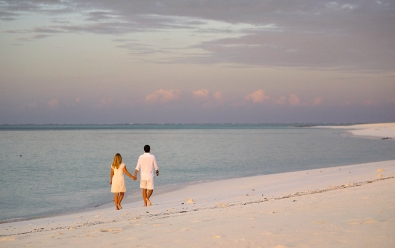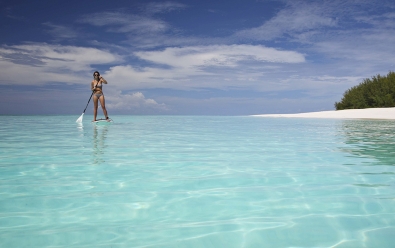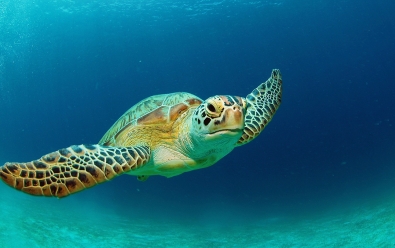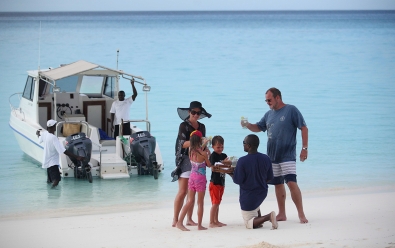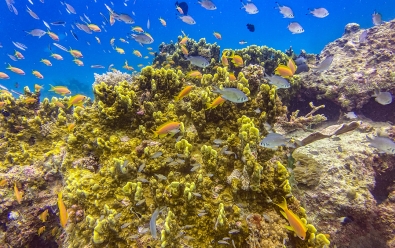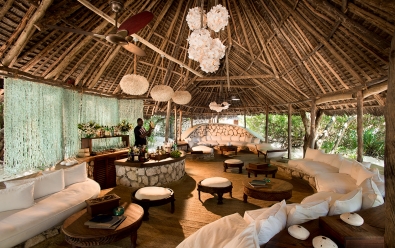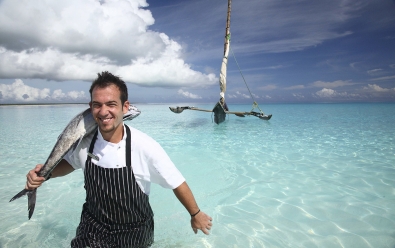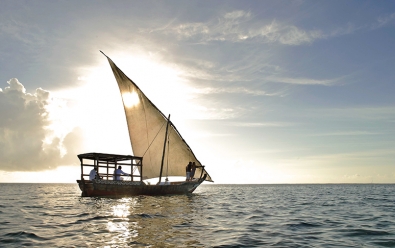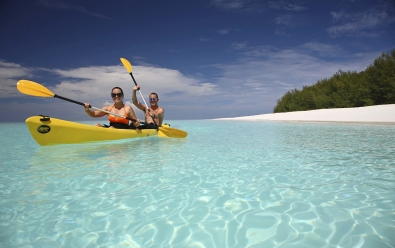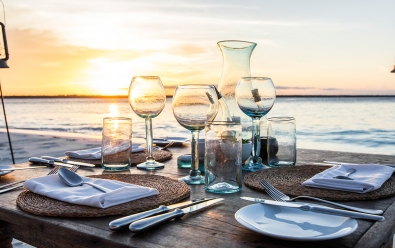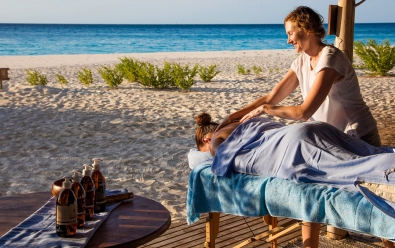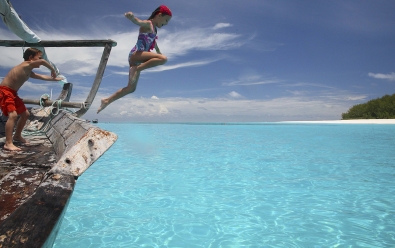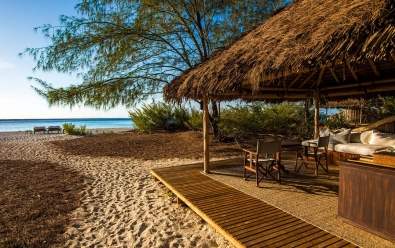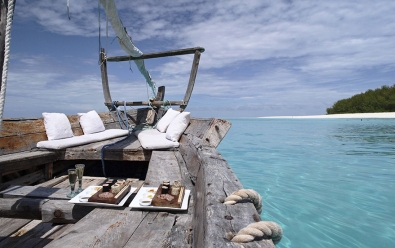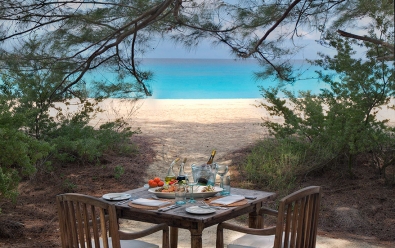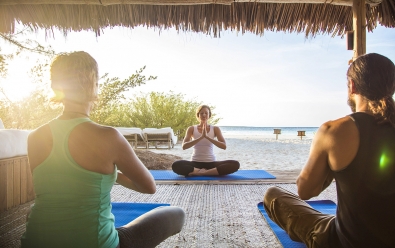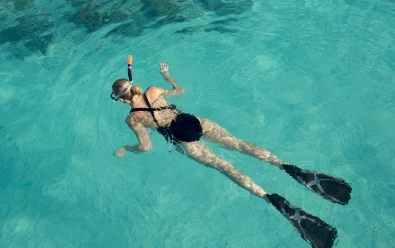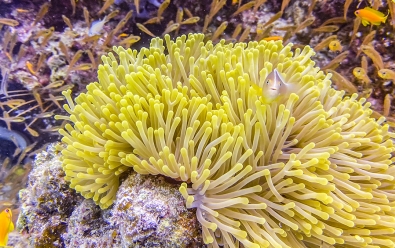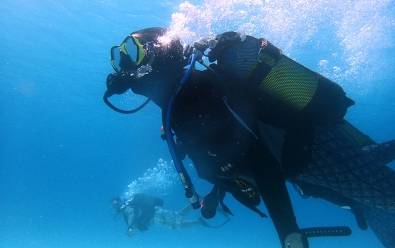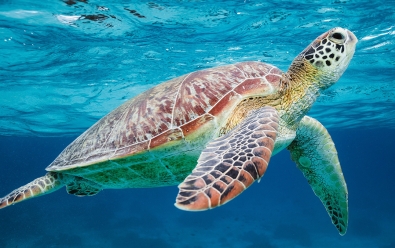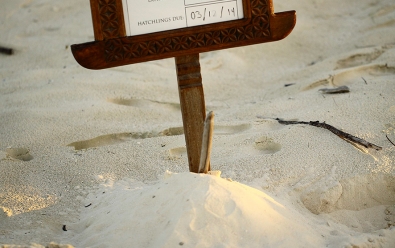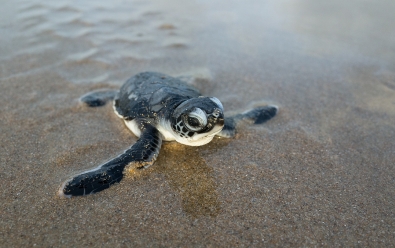Mnemba Island
Location
- Mnemba Island
- Zanzibar Archipelago
- NE Tanzania / Indian Ocean
Mnemba is a tiny, private island located in the tropical Zanzibar Archipelago, offering idyllic exclusivity to its guests.
Zanzibar is steeped in history, with centuries of Indian Ocean merchants from the Far East sailing its waters and trading spices, slaves, ivory, and items from the Orient. Zanzibar's exotic islands include beautiful beaches, tropical air, warm Indian Ocean waters and are home to a great diversity of cultures. A visit to the islands is a great add-on to a wildlife safari in East Africa.
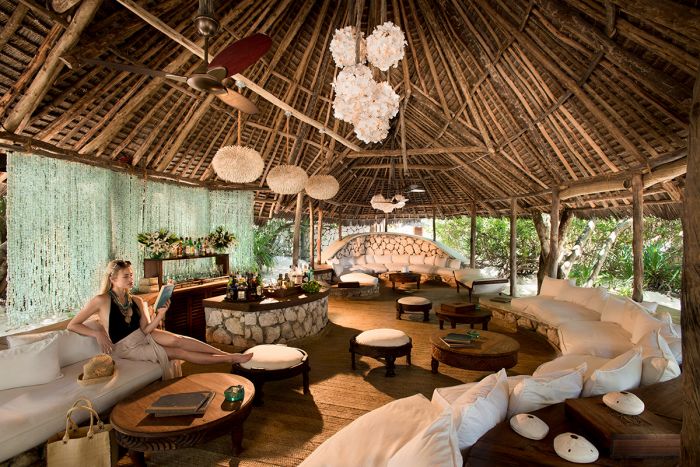
The open-air main guest area on Mnemba Island.
The waters surrounding the island are spectacularly clear and warm and guests can safely swim and snorkel in the calm waters right from the beach.
Activities offered include diving, snorkeling, swimming, sunset cruises in a traditional dhow, kayaking, stand-up paddle boarding, fly fishing from the beach, experiencing green turtles nesting or hatchlings emerging, and more. Private yoga lessons and wellness treatments are offered as well.
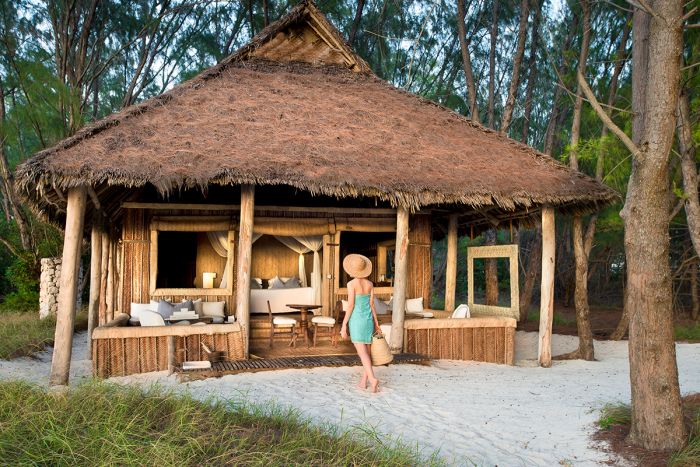
Guest banda on Mnemba Island.
Breakfast trays full of fresh, tropical fruits, freshly-squeezed juice, and Tanzanian coffee can be delivered to your banda or going the other guests in the open-air main dining area.
Fresh fish, including professionally-prepared sushi, fruits, and vegetable are offered daily and wine or chilled Champagne is always available. Romantic candlelit dinners are served on the beach, with the waves lapping gently on the sand in the warm, tropical air.
About Zanzibar
Zanzibar consists of two main islands and about 50 much smaller islands lying 25-50 miles (40-80 kms) offshore from the northern coast of Tanzania, which is known as the Swahili Coast.
Most of Zanzibar's population, which numbers around 1.1 million, live on its two largest islands, Unguja (also known as Zanzibar Island) and Pemba. Roughly two-thirds live on Unguja, while most of the rest live on Pemba. Small numbers live on Tumbatu, Fundo, and some of the other small islands in the archipelago.
Zanzibar is a semi-autonomous region belonging to the Republic of Tanzania, with its own government.
The Zanzibar Archipelago have long produced cloves, nutmeg, cinnamon, vanilla, and black pepper and together with Mafia Island further south along Tanzania's coast, are known as the "Spice Islands".
Read more about Zanzibar's history on our Zanzibar region page.
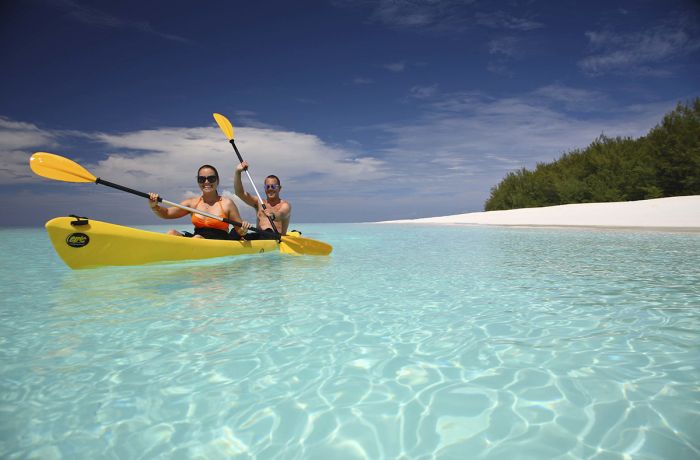
Kayaking in the warm, turquoise water at Mnemba Island.
Unguja Island
Unguja Island covers an area of 643 square miles (1 666 sq kms), measuring 53 miles (83 kms) north-to-south and 19 miles (30 kms) east-to-west at its widest. Zanzibar's capital is Zanzibar City, located on the west coast of Unguja and the only significant urban center on the islands. Zanzibar's top tourist draw is Stone Town, the old Arabian-style quarter of Zanzibar City.
The northern tip of Unguja, around the traditional fishing and dhow-building village of Nungwi, has become Zanzibar's most popular tourist retreat, owing to the myriad water sports available including superb snorkeling and diving. Once an enclave for hippies, Ras Nungwi has emerged as the place to be on Unguja, with a multitude of accommodations, seafood restaurants, and a lively nightlife scene.
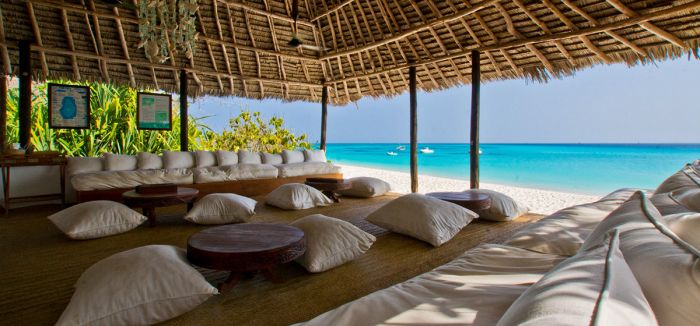
The open-air guest lounge at Mnemba Island.
Pemba Island
Located 25 miles (40 kms) northeast of Unguja lies Zanzibar's oft overlooked 'other' big island, Pemba. Often called the "Green Island", owing to its lush and densely vegetated landscape, the island covers an area of 381 square miles (988 sq kms), measuring 42 miles (67 kms) north-to-south and 14 miles (22 kms) east-to-west at its widest.
Pemba is infrequently visited, as it is not touted as a tourism destination by the Zanzibari government. Pemba's infrastructure is far less developed than Unguja, but is far quieter and retains a true old world feel. The island and its offshore reefs are best known for having numerous world-class dive locations. Pemba also offers lovely beaches and several ruin sites.

Each guest banda includes a private beach lounge closer to the water.
About Mnemba Island
The tiny island of Mnemba is located just 1.5 miles (2.5 kms) off the northeast coast of Unguja. The island is part of the mostly submerged Mnemba Atoll. Mnemba Island is rough triangular in shape and has a circumference of just around 0.9 miles (1.5 kms), covering just around one-tenth of a square mile. The entire Mnemba Atoll spans roughly 7 square miles (18 sq kms).
The island is private for guests staying at the desert lodge, but the waters offshore are popularly used by day visitors from Unguja, who come to enjoy the crystal clear waters for snorkeling and diving. There is a 650-foot (200-meter) exclusion zone around the island, within which day-visitors are not permitted.
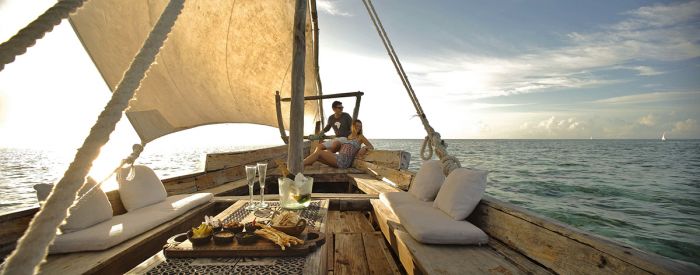
A sunset cruise on a traditional dhow at Mnemba Island.
Marine Conservation Area
In 2005, andBeyond worked with the Zanzibar Department of Fisheries and members of local Zanzibari fishing communities to form the Mnemba Island Marine Conservation Area (MIMCA). In addition to other measures, this protected area officially demarcated specific areas for snorkeling, diving and fishing. The agreement also resulted in the introduction of a daily recreational fee for the use of these areas. The revenue generated by this levy was used to fund local community projects and benefit local fishermen.
One of the main objectives of the establishment of MIMCA was to reduce the incidence of net fishing in the shallow waters off the coral reefs and encourage fishing for fewer and larger species further out, in deeper waters. Several measures were introduced to encourage this practice. The boundaries of MIMCA have since been extended to include a far larger portion of the Zanzibar coastline.
Wildlife
Wildlife seen at Mnemba Island consists primarily of marine species and sea birds; however, one terrestrial species of note living on the island is Aders's duiker (Cephalophus adersi), a small, shy, and critically endangered antelope. It is considered to be the rarest antelope in Africa, with only 300-600 estimated to survive today. The species is restricted to small patches of coastal forest in Kenya and Zanzibar. They stand just 12 inches (30 kms) tall at the shoulder and adults weigh only 17 pounds (7.5 kgs).
In 2005, five Aders's duikers were introduced to Mnemba Island as part of a species survival plan. There are no natural predators on the island and ta good supply of their preferred food. The population has tripled since then, with a population of 15 individuals now living on the island.
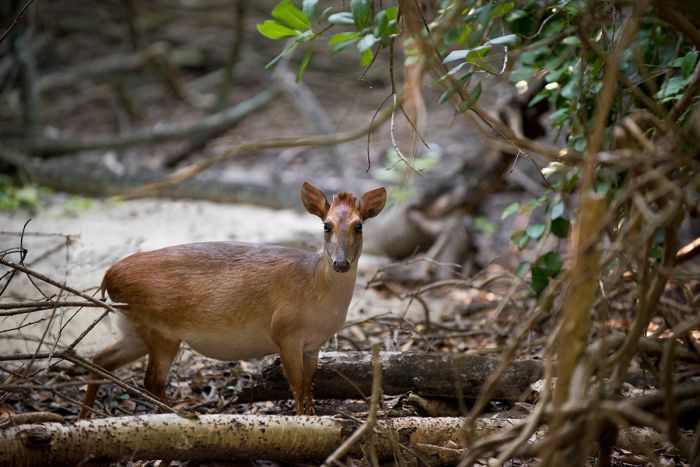
Aders's duiker (Cephalophus adersi) has been successfully introduced on Mnemba Island.
Gigantic humpback whales pass through the deep-sea channel between Mnemba and Zanzibar on migration (usually from July to September). Common, bottlenose, and spinner dolphins are present throughout the year and pods of these charismatic animals often come close to shore. A population of tiny suni antelope (introduced) inhabit the casuarina forest on the island and may be seen tiptoeing around near the guest rooms.
Sea turtles are often seen when snorkeling around Mnemba Island and the pristine beaches here are used by green turtles as a nesting site. The green turtle (Chelonia mydas) nests on Mnemba have been actively protected and monitored by a conservation project since 1996.
To learn more about the green turtles on Mnemba Island, watch the video below.
Over 50 species of bird have been recorded at Mnemba. Migratory waders including lesser sand-plover, curlew sandpiper, whimbrel, and ruddy turnstone gather on sand spits alongside flocks of elegant crab-plover. Great crested tern, sooty gull, and dimorphic egret are frequently seen hunting for fish along the shore. Large numbers of red-eyed dove roost and nest on the island. Palm-nut vulture and African harrier-hawk are among visiting raptors. Purple-banded sunbird, African reed warbler, and paradise flycatcher are resident at the forest edge. Unusual birds such as harlequin quail may appear sporadically.
Nearly 600 species of species of brilliantly colored reef fish occur around Mnemba and the surrounding reefs. Among the most striking are moorish idol, palette surgeonfish, and clown triggerfish. Geometric moray eel, giant frogfish, and freckled anglerfish (frogfish) are among the stranger denizens of these coral reefs. There are 168 species of fish on Mnemba’s house reef – just a five-minute swim from the beach. Enormous whale sharks (the world’s largest fish) are regularly encountered in deep water channels. Groups of hammerhead sharks are located occasionally.
ROOMS INCLUDES & EXCLUDES CHILDREN FACILITIES ACTIVITIES
Accommodation
12 guest accommodations in total comprising:
- 12 beachside bandas, each with two three-quarter beds (separate mattresses with shared base). Mattress converters are available that transform the twin beds into a double bed. One of the bandas is available as a triple (adult(s) and children 16 years and younger).
- Two of the bandas have a covered walkway linking the front decks to each other, converting them into a double unit, which is ideal for a family. This double banda can accommodate two adults in the main bedroom and two children under 16 years in the second bedroom. A third child can be accommodated on request.
All of the bandas are constructed using wood and palm fronds. The bandas are adorned with contemporary Zanzibari and Indian Ocean décor.
Every banda includes en-suite facilities with a double-basin vanity, indoor shower, and separate toilet. The bandas are accessed via sand footpaths on the ground leading to the main guest area.
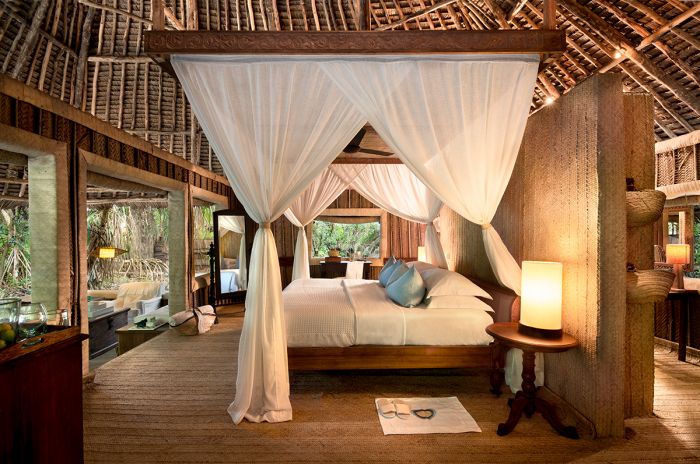
Guest banda bedroom at Mnemba Island.
Each rustic guest banda is built just off the beach at the edge of the island's tropical forest and has an attached outdoor deck in the front, accessed by large, open-air doorways. Roll-down palm coverings can close off the windows and door, but are typically left open to allow the sea breeze to enter. The bandas are raised slightly off the sand.
Each banda also has its own private beach lounge located around 60 feet (20 meters) towards the ocean. The beach lounge is constructed atop a slightly raised wooden deck and is covered by a thatched roof. The sides are open, but have roll-down palm-frond coverings. The lounges have a comfy shaded couch / daybed, a table and chairs for dining, a supplies chest with private bar, and a shower for rinsing off or just cooling down.
The bandas are spacious, covering 1 012 square feet (94 sq meters) in area and well spaced, with a distance of 35-50 feet (11-15 meters) between each banda.
Other items and features in the guest suites include:
- Private veranda with beach and ocean views.
- Gym-in-a-basket.
- Healing Earth treatments offered in-room.
- Personal bar.
- In-room Wi-Fi (also available in main guest area).
- Mosquito netting over the bed.
- Overhead fan.
- Telephone (intermittent GSM mobile reception).
- Hairdryer.
Mnemba Island can accommodate a maximum of 25 guests in total: 2 persons in each of the 12 guest bandas, with two banda convertible to a triple.
Includes & Excludes
Includes:
- All meals and local beverages including soft drinks, house wines, local brand spirits and beers, teas, and coffees.
- Water sports (scuba diving: 2 dives per day, full PADI certification required, snorkeling, kayaking, fly fishing, sundowner dhow cruise, stand-up paddle boarding).
- WILDchild program for kids.
- Laundry services are provided on a daily basis (weather permitting, items will be returned on the same day). Laundry is dried by the sun and on most days any laundry placed out in the morning will be returned by the evening.
- Emergency medical evacuation insurance.
- Wi-Fi access.
- Tourism Levy & VAT.
Excludes:
- Healing Earth wellness treatments.
- Purchases from the Island Shop.
- Champagne, cognacs, fine wines, premium brand spirits, and cigars.
- Yoga classes.
- Diving instruction for adults and children over the age of 12 years without a PADI certificate.
- PADI dive courses.
- Any applicable wildlife fee, park fee, reserve fee, concession fee, other land-use fee.
Single Supplement
A single supplement may apply for any room booked by a single traveler; please ask us for pricing.
Children
Families and groups will fall in love with the tranquility of the island. The lodge will only accommodate a maximum of two children under 12 years of age at any given time. Travel to Mnemba Island is recommended for children eight years of age or older.
Children of any age are accommodated at Mnemba Island:
- 1 triple banda is available as well as the family banda.
- Please note: The guest area is not fenced off and children are required to have an adult accompanying them at all times.
- While the island does not have trained child minders, it can offer the services of certain staff members who are wonderful with children. This will be at an additional cost (best to pre-book this with us).
AndBeyond’s WILDchild programme, designed especially for children aged 3-12 years, is filled with fun, interactive activities that offer opportunities to learn and discover new experiences and cultures. The program is intended to create a series of unforgettable moments for the whole family, while forging strong bonds between young guests, our planet, and its people.
Wildchild activities include:
- A delightful scavenger hunt.
- Embarking on a pirate ship trip around the island.
- Snorkeling.
- Beach picnics.
- Nature walks.
- Baking 'turtle' biscuits with the lodge chef.
Facilities
Tucked into the edge of the island's casuarina pine forest, palm-thatched dining, lounge, and bar areas boast beautiful, open views of the beach, ocean, and Zanzibar Island in the distance.
Main guest area facilities include:
- Open-air dining and lounge areas under palm-thatched roofing.
- Bar.
- Two dive centers; one on the north side of the island and one on the south, used in accordance with the weather patterns. Both are stocked with equipment for diving, snorkeling, kayaking, and stand-up paddle boarding. The lodge has a PADI dive school with qualified dive instructors.
- Air-conditioned Island Shop selling beachwear, jewelry, rash vests, beach necessities such as hats and sunscreen, and other accessories.
- Library.
- Tree nursery.
- Wellness treatments and yoga classes are offered privately in-banda.
- Complimentary Wi-Fi access (also available in the guest suites).
- Guest toilets in main area.
Activities
Activities included in the rate:
- Swimming and snorkeling right off the beach.
- Snorkeling offshore (accessed by a 10-minute boat ride).
- Scuba diving; two dives per day, full PADI certification required. The reefs are quieter from February to June, offering more exclusive dives.
- Dhow sunset cruises.
- Guided forest walks around the island.
- Birding.
- Kayaking.
- Fly fishing from shore.
- Stand-up paddle boarding.
- Green turtle nesting and hatching activities (seasonally). Turtle nesting season on Mnemba Island is from February to July, with the peak occurring April to July. The hatchling season is between May and September, with the peak occurring June to August.
- WILDchild program for kids.
Optional activities at additional cost:
- Yoga classes.
- Diving instruction for guests under the age of 12 years and adults without a PADI certificate.
- PADI dive courses.
- Wellness treatments (offered privately at your banda).
Example of a typical day:
- Choose exactly how and where you would like to spend your day and the attentive staff will make it happen.
Great Good Fair Poor
- Jan
- Feb
- Mar
- Apr
- May
- Jun
- Jul
- Aug
- Sep
- Oct
- Nov
- Dec
General Tips
The best time to visit Zanzibar is from June to October, which is the dry season. The same weather patterns of affect most of northern Tanzania, so combining Zanzibar with a safari works quite well in terms of seasonal rainfall. Most visitors prefer to do the safari portion of the trip first, followed by the tropical beaches and air of Zanzibar.
Besides for the period during the 'long rains', which is March through much of May, Zanzibar can be visited at any time.
Mnemba Island is closed for the long rains between 08 April and 20 May.
RAINS
The rainy season in northern Tanzania is from November thru mid-May, with two distinct rain seasons. The "Short Rains" (locally called the "mvuli") fall from mid-November to mid-December and are generally lighter and less impactful to safari activities. The "Long Rains" (locally called the "masika") occur between March and May, brining afternoon showers on a near daily basis.
Short Rains
The short rains occur for about one month sometime during November and December (the exact time varied somewhat year to year). This period is called the 'short' rains because the duration of an individual rain event is short and it is rare to have an all-day rain event. Most rain falls as an afternoon shower, while mornings are typically overcast or clear.
Long Rains
The long rains occur between March and May, with April being the wettest month of the year. During this time, rain should be expected almost every day and the showers can last for hours at a time, although all-day rain is not typical. Cloudy skies are typical and temperatures can be chilly at times.
The period between the short and long rains (January and February) also receives rainfall, but many days are clear and the amount and duration of the rain events is unpredictable, with some afternoon showers and the odd long and heavy shower.
Jul through September (as well as February) are the months receiving the least amount of rainfall, but rain can occur at any time during there year in Zanzibar. April and May are by far the wettest months.
Some beach resorts and hotels are closed for some or all of the long rains from March thru May.
Temperatures
The islands of Zanzibar are warm all year due to their close proximity to the equator (between 5 and 6 degrees south). Over the year, the days average a low of 75°F (24°C) and a high of 84°F (29°C).
November through March are the warmest months of the year, with daytime temps reaching an average high of 90-94°F (32-34°C) and falling to 71-74°F (22-24°C) overnight. June through August experience slightly cooler temps, with days averaging a high of 85-86°F (29-30°C) and nighttime temps averaging 69-71°F (20-21°C).
Diving & Snorkeling
The water temperature around the Zanzibar Archipelago averages 79-81°F (26-27°C) throughout the year and underwater visibility averages 65-165 feet (20-50 meters). There are numerous offshore reefs all around the Zanzibari islands and it is a great diving and snorkeling destination throughout most of the year.
The best time to visit northern Zanzibar for diving and snorkeling is from June to October, while the south coast is great between November and March.
Mnemba Island is a small above-water piece of the much larger Mnemba Atoll, which offers excellent diving and snorkeling. The months of September through December are very good for sea turtles, dolphins and whale sharks, but the reefs offers superb marine life viewing all year.
Turtles
Green turtles lay their eggs on the beaches of Mnemba Island from February to July, with the peak laying period occurring between April and July. The turtles come ashore, typically at night, and dig a hole with their flippers, where they lay their clutch of eggs. The average number of eggs laid for green turtles is around 110, but can be as many as 150 eggs. After laying her clutch, the female covers the eggs with sand and goes back to the ocean.
Mnemba Island's staff patrol the beaches each morning to look for new turtle activity. Any new nest sites are marked with a sign stating the date. The nests are carefully protected and watched over by the staff and researchers at Mnemba Island.
The incubation period for green sea turtles is 55-60 days and when the baby turtles emerge from their eggs, the hatchlings must dig themselves up and out of the sand and scramble towards the water. Guests at Mnemba Island can be there to experience the hatchlings on the day they emerge and head to the water. It is a wonderful experience to be sure. Hatchling season on Mnemba Island is between May and September.




